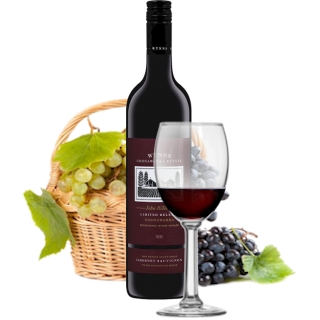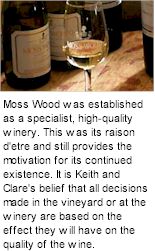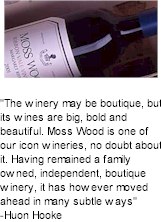


A study by viticulturist, Dr John Gladstones, first drew attention to the suitability of the Margaret River region for making wine. Gladstones believed that the soil found in the area, clay subsoil covered by gravelly loam, was ideal for viticulture. He compared the Margaret River climate with that of Bordeaux, indicating that both had an average rainfall of over 1000mms and an absence of temperature extremes, because of the influence of the sea on three sides.

One of the first to be influenced by Gladstones' theory was Bill Pannell who spent six months searching the Margaret River area for ideal land for a vineyard. He chose a site at Wilyabrup and persuaded the owner, Jack Guthrie, to sub-divide his land and to sell the block, which became Moss Wood.
Bill and Sandra Pannell commenced work on the Moss Wood Vineyard in 1969 at the same time as the Hohnens were developing Cape Mentelle and just two years after Dr Tom Cullity began the first vineyard in the area at Vasse Felix. A nursery for Cabernet was established in 1969, and the next year, two hectares of Cabernet Sauvignon were planted. The first vintage took place in 1973 when 250 dozen bottles of Moss Wood Cabernet Sauvignon was made. The Moss Wood Pinot Noir was first produced in 1977
Semillon was the first white wine planted at Moss Wood because suitable cuttings of Chardonnay did not become available in Western Australia until 1976. The first crop of Semillon was harvested in 1976, although a commercial release was not possible until the next vintage. Similarly, the first vintage of Chardonnay, in 1980, was not released commercially and as the next two crops were destroyed by bad weather, the public did not see a Moss Wood Chardonnay until the 1983 vintage.

In 1978, Roseworthy graduate, Keith Mugford, was employed to run the winery and in 1985 Keith and Clare Mugford purchased Moss Wood. The past decade has seen significant developments including re-trellising, in line with new developments in vine management in Australia, and the planting of Cabernet Franc, Merlot and Petit Verdot for blending with the Cabernet Sauvignon.
A belief that the quality of the wine is largely determined in the vineyard means that continual efforts are made at Moss Wood to improve viticultural techniques. This can be seen in the changeover to the Scott Henry trellising system for the Chardonnay and Pinot Noir and the adoption of the similar Te Kauwhata Two Tier system for the recently planted Cabernet Franc, Merlot and Petit Verdot. These changes have reduced the density of the foliage and exposed the grapes to more sunlight. Not only has this improved quality and crop yield but also it has made picking, pruning and spraying easier and quicker. Experimentation in the vineyard has been matched at the winery and the wines have undergone subtle refinements over the past decade. Two factors have resulted in the production of Moss Wood Cabernet Sauvignon, which are more complex and have greater finesse. The wines are given longer skin contact time during fermentation and small amounts of Cabernet Franc (5%) and Merlot (0.05%) are now included in the blend. From the 1995 vintage onwards, Petit Verdot has contributed 5% to the wine. The benchmarks for the Moss Wood style, however, remain the Cabernet Sauvignons made between 1974 and 1977.
Burgundian influences have seen new techniques used in the production of Moss Wood Pinot Noir: the addition of whole bunches of grapes to the crush, longer skin contact time during fermentation and hand and feet plunging to mix the skins while the must is fermenting. These refinements in winemaking have been responsible for an improvement in the quality and consistency of the style. Keith and Clare Mugford enjoy the challenge of consistently producing high quality wines at Moss Wood. By striving to implement appropriate viticultural and vinicultural advances, they aim to further improve their understanding of premium wine production and enable Moss Wood to maintain its position as a leading Australian winery.
